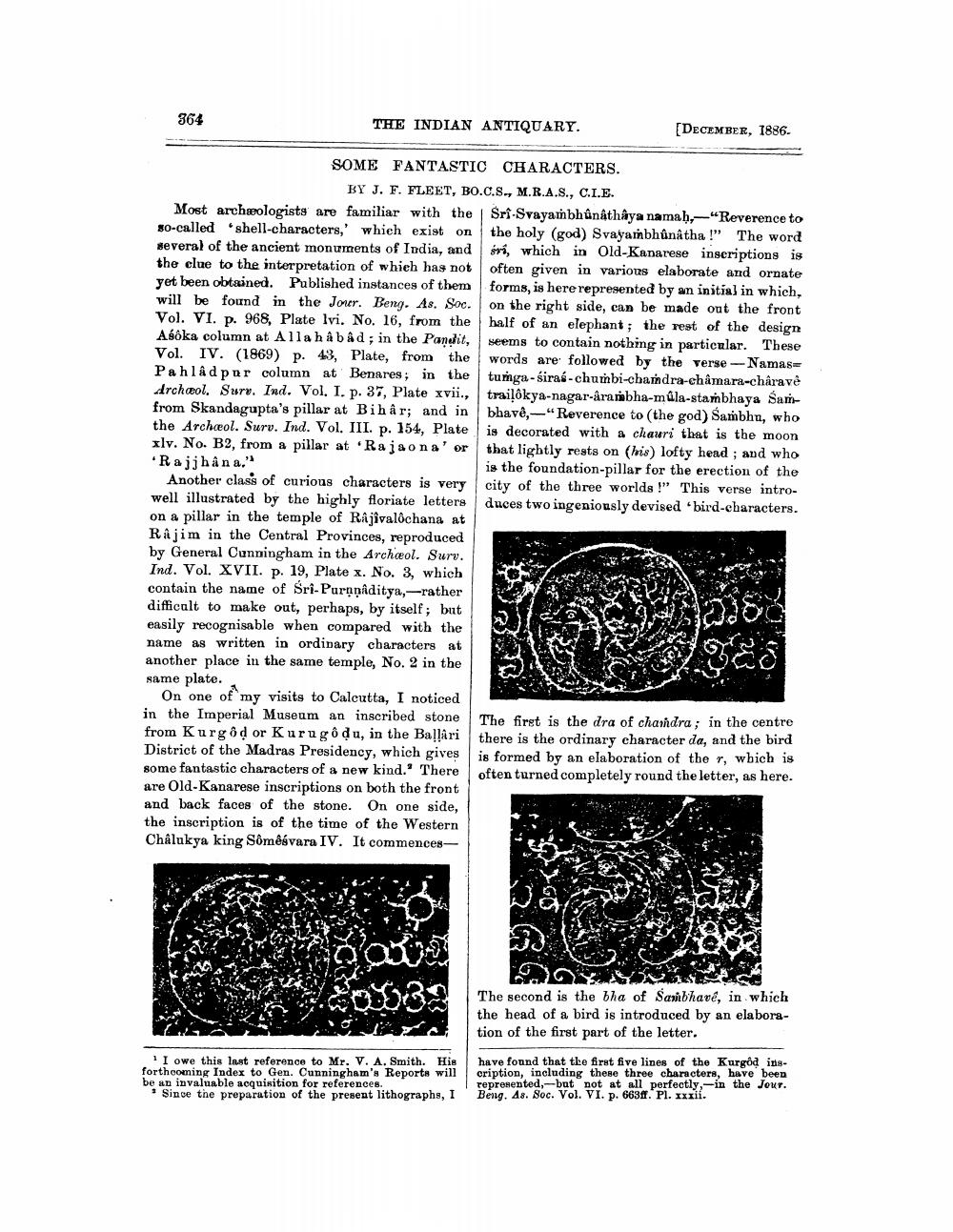________________
364
THE INDIAN ANTIQUARY.
SOME FANTASTIC CHARACTERS. BY J. F. FLEET, BO.C.S., M.R.A.S., C.I.E.
Most archaeologists are familiar with the Sri-Svayambhunathaya namaḥ,-"Reverence to so-called shell-characters,' which exist on the holy (god) Svayambhunatha!" The word several of the ancient monuments of India, and ri, which in Old-Kanarese inscriptions is the clue to the interpretation of which has not often given in various elaborate and ornate yet been obtained. Published instances of them forms, is here represented by an initial in which, will be found in the Jour. Beng. As. Soc. on the right side, can be made out the front Vol. VI. p. 968, Plate Ivi. No. 16, from the half of an elephant; the rest of the design Aśoka column at Allahâbâd; in the Pandit, seems to contain nothing in particular. These Vol. IV. (1969) p. 43, Plate, from the words are followed by the verse-Namas= Pahlâdpur column at Benares; in the tumga-siras-chumbi-chandra-châmara-châravé Archeol. Sure. Ind. Vol. I. p. 37, Plate xvii., trailôkya-nagar-arambha-múla-stambhaya Samfrom Skandagupta's pillar at Bihâr; and in bhavê,-"Reverence to (the god) Sambhu, who the Archeol. Surv. Ind. Vol. III. p. 154, Plate is decorated with a chauri that is the moon xlv. No. B2, from a pillar at Rajaona' or that lightly rests on (his) lofty head; and who Rajjhana," is the foundation-pillar for the erection of the city of the three worlds!" This verse introduces two ingeniously devised 'bird-characters.
4
Another class of curious characters is very well illustrated by the highly floriate letters on a pillar in the temple of Râjivalochana at Rajim in the Central Provinces, reproduced by General Cunningham in the Archaeol. Surv. Ind. Vol. XVII. p. 19, Plate x. No. 3, which contain the name of Sri-Purnnâditya,-rather difficult to make out, perhaps, by itself; but easily recognisable when compared with the name as written in ordinary characters at another place in the same temple, No. 2 in the same plate.
On one of my visits to Calcutta, I noticed in the Imperial Museum an inscribed stone from Kurgôd or Kurugô du, in the Ballari District of the Madras Presidency, which gives some fantastic characters of a new kind." There are Old-Kanarese inscriptions on both the front and back faces of the stone. On one side, the inscription is of the time of the Western Chalukya king Sômêsvara IV. It commences
200 80533
[DECEMBER, 1886
I owe this last reference to Mr. V. A. Smith. His forthcoming Index to Gen. Cunningham's Reports will be an invaluable acquisition for references.
3
Since the preparation of the present lithographs, I
A5180 Jes
The first is the dra of chandra; in the centre there is the ordinary character da, and the bird is formed by an elaboration of the r, which is often turned completely round the letter, as here.
20
The second is the bha of Sambhave, in which the head of a bird is introduced by an elaboration of the first part of the letter.
have found that the first five lines of the Kurgôd inscription, including these three characters, have been represented, but not at all perfectly,-in the Jour. Beng. As. Soc. Vol. VI. p. 663ff. Pl. xxxii.




